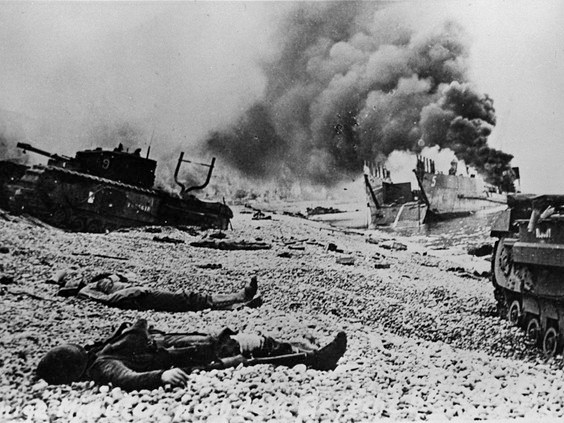The Juno Beach Centre’s exhibition commemorating the 80th anniversary of the Dieppe Raid features the testimonies of people who participated in the battle or were affected by it.
The exhibition gives space to voices not often heard, such as mothers, wives, citizens of Dieppe and prisoners of war. It also immerses visitors in the events of that historic day on Aug. 19, 1942, while allowing them to understand why Dieppe was so important to Canadians of yesterday and today.
The museum — located in Normandy, France — has presented the testimony of five individuals to give visitors a better understanding of who was affected.
Capt. Laurence Guy Alexander, or “Doc Alexander,” served in the First World War. At the outbreak of the Second World War, he recognized the need for medical personnel and enlisted in the Calgary Regiment in 1941. On Aug. 19, 1942, he was wounded during the Dieppe Raid. He returned to England and was awarded the Military Cross by King George.
He then served in Italy, Normandy, and Northwest Europe. At the end of the Second World War, he returned to Canada. Doc Alexander worked tirelessly to rebuild his practice. He treated the Stoney-Nakoda First Nations.
Jack A. Poolton was born in Kapuskasing, Ont. In 1940, aged 21, he joined the Royal Regiment of Canada. During the Dieppe Raid, his regiment landed on Blue Beach in Puys. He survived the initial raid but was captured.
Poolton was imprisoned in Stalag VIII-B, a prison camp in Poland. He remembers he and other Canadians being shackled, as well as the cold, the lice, the rats and the lack of supplies that plagued the camp.
Poolton made many escape attempts, but each time he was caught. He also survived the cold and starvation of the death marches in winter 1945, when the Germans evacuated his camp to escape the Russian advance.
After the war, Poolton worked as a mechanic, married Colette Desrosiers, and had three children. He suffered from a duodenal ulcer, constant headaches, bouts of depression, and post-traumatic stress disorder.
His legacy lives on with his daughter, Jayne Poolton-Turvey, who leads the Dieppe – Blue Beach – Every Man Remembered project to keep the memory of Jack and his comrades alive.
Lt. George Depoorter, Royal Naval Reserve, was a pre-war Belgian naval commissioner. He joined the Royal Navy Section Belge in January 1942 and served as a gunnery officer on the troop carrier HMS Queen Emma from June 1942. On Aug. 19, 1942, this ship landed the part of the Royal Regiment of Canada at Blue Beach (Puys).
Depoorter later participated in the landings in North Africa, Sicily and Normandy at Juno Beach. After the war, he joined the Belgian Navy and reached the rank of captain.
In 1946, Depoorter was awarded the Belgian Croix de Chevalier de l’ordre de la Couronne avec Palme. The citation highlighted his efforts at Dieppe: “under heavy enemy fire, in difficult circumstances, he took command of an assault craft and brought many wounded men aboard.”
Sister Agnès Cécile Marie-Madeleine received training from the Red Cross and became a nurse in 1936. In 1942, she was serving as a nursing sister in the Hôtel-Dieu hospital in Rouen. At the time, the hospital was the site of a German surgical branch for casualties of the Dieppe Raid.
Even when the German soldiers ordered that priority should be given to their wounded, Sister Agnès insisted on caring for the worst-injured men first, regardless of which side they fought on.
Her actions saved the lives of many Canadian soldiers. One such man, Edwin Bennett of the Calgary Regiment, endured a shrapnel wound in the eye. Thanks to her, Bennett regained his sight. Later, he recalled, “It was wonderful to hear a woman’s voice, someone who was comforting. I’ll always remember her voice.”
Sister Agnès received the Ordre National du Mérite in 1992 and the Légion d’Honneur in 1996. For years, she was involved in ceremonies commemorating the Dieppe Raid. On those occasions, she met many Dieppe veterans, including those she had personally cared for.
Canadian soldiers remembered her fondly, calling her the “White Angel” or the “Angel of Dieppe.”
Sub-Lt. Andrew Wedd was tasked with commanding an assault craft during the Dieppe Raid on Aug. 19, 1944. Wedd’s landing craft carried soldiers of Les Fusiliers Mont-Royal. For his “gallantry, daring, and skill” during the Dieppe Raid, Sub-Lieutenant Andrew Allan Wedd, RCNVR was awarded the Distinguished Service Cross.
Following the Dieppe Raid, Wedd was involved in all the Allied combined operations in Europe. In November 1942, Wedd, as an officer in the 1st Canadian Landing Craft Flotilla, took part in Operation Torch, the Allied invasion of French North Africa. In July and August of 1943, he commanded a landing barge during Operation Husky, the Allied invasion of Sicily.
Promoted to full lieutenant, Wedd concluded his service overseas with the 262nd Canadian Landing Craft Flotilla. He commanded a Landing Craft Infantry (Large) at Juno Beach during the Normandy landings on June 6th, 1944.
Damaged by submerged German beach obstacles, his landing craft brought reserve units of the 3rd Canadian Infantry Division ashore at Bernières-sur-Mer (Nan White Beach).
Visit www.junobeach.org for more information about the exhibition.




